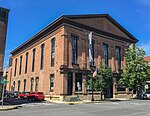Cornelius H. Evans House
1861 establishments in New York (state)Houses completed in 1861Houses in Columbia County, New YorkHouses on the National Register of Historic Places in New York (state)Hudson, New York ... and 3 more
Individually listed contributing properties to historic districts on the National Register in New York (state)NRHP infobox with nocatNational Register of Historic Places in Columbia County, New York

The Cornelius H. Evans House is located on Warren Street in downtown Hudson, New York, United States. It is a brick house dating to the mid-19th century. It was the home of Evans, a local brewer and businessman who served two terms as the city's mayor. His descendants remained in the house for 80 years. After being used as a synagogue and community center for short periods, it has returned to residential use. On November 1, 1974, it was listed on the National Register of Historic Places. It is also a contributing property to the Hudson Historic District.
Excerpt from the Wikipedia article Cornelius H. Evans House (License: CC BY-SA 3.0, Authors, Images).Cornelius H. Evans House
Warren Street,
Geographical coordinates (GPS) Address Nearby Places Show on map
Geographical coordinates (GPS)
| Latitude | Longitude |
|---|---|
| N 42.250833333333 ° | E -73.788055555556 ° |
Address
Warren Street 412
12534
New York, United States
Open on Google Maps






